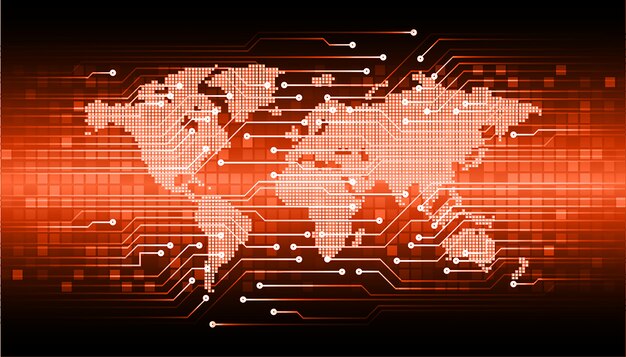Global Cyberattacks 2025: Impact on US National Security

A projected 15% increase in global cyberattacks by 2025 poses a significant threat to US national security, exacerbating vulnerabilities across critical infrastructure, defense systems, and economic stability through sophisticated, state-sponsored, and financially motivated cyber warfare.
As the digital landscape evolves, so do the threats lurking within it. The prospect of a projected 15% increase in global cyberattacks impacting US national security in 2025 raises critical questions about resilience, defense, and strategic preparedness. This anticipated surge transcends mere statistics; it signals a profound challenge to the very foundations of American stability.
Understanding the Escalation of Cyber Threats
The digital realm has become an undeniable battlefield, where adversaries operate without geographical borders. The projected 15% surge in global cyberattacks by 2025 is not an arbitrary figure; it reflects a confluence of factors, including the proliferation of advanced persistent threats (APTs), the increasing sophistication of ransomware, and the widening attack surface presented by interconnected systems. This escalation demands a nuanced understanding of its origins and implications.
One primary driver behind this predicted increase is the continued investment by nation-states in offensive cyber capabilities. These entities often seek to gain geopolitical advantages, disrupt critical infrastructure, or steal sensitive information. Beyond nation-states, organized cybercrime syndicates and financially motivated bad actors are also refining their tactics, posing a direct threat to economic stability and individual privacy. The commoditization of hacking tools and services on the dark web further lowers the barrier to entry for aspiring attackers.
The Proliferation of Ransomware and Supply Chain Attacks
Ransomware, once a nuisance, has evolved into a national security concern. Its ability to cripple essential services, as seen in the Colonial Pipeline attack, underscores its disruptive potential. The focus of attackers has shifted from individual users to large organizations and critical infrastructure, where the potential for high payouts and widespread disruption is maximized.
- Economic Impact: Ransomware attacks can lead to significant financial losses, not just from ransom payments but also from business interruption, recovery costs, and reputational damage.
- Critical Service Disruption: Attacks on hospitals, energy grids, and water treatment facilities can have dire consequences for public safety and national welfare.
- Supply Chain Vulnerabilities: Exploiting a single vulnerability in a widely used software component or service can grant attackers access to numerous downstream organizations, creating a cascade effect.
Simultaneously, supply chain attacks have emerged as a stealthy and effective method for breaching secure networks. By compromising a trusted vendor or software update, attackers can bypass traditional security measures, gaining access to countless targets without directly attacking them. This method leverages the inherent trust within digital ecosystems, making detection and prevention extraordinarily challenging. The SolarWinds incident served as a stark reminder of how deeply embedded and insidious these attacks can be.
State-Sponsored Cyber Espionage and Warfare
Beyond financial gain, state-sponsored actors engage in cyber espionage to acquire sensitive government data, intellectual property, and defense secrets. Their attacks are often highly targeted, persistent, and utilize zero-day exploits, making them particularly difficult to detect and defend against. The lines between espionage and outright cyber warfare are blurring, with potential for disruptive attacks that could impact military readiness or civilian life.
- Information Theft: Stealing classified documents, military strategies, and advanced technological blueprints can give rival nations a significant strategic advantage.
- Disinformation Campaigns: Cyber operations are increasingly used to spread misinformation and manipulate public opinion, undermining democratic processes.
- Infrastructure Sabotage: While less common, the capability for state-sponsored actors to sabotage critical infrastructure remotely poses an existential threat.
This evolving threat landscape necessitates a comprehensive, adaptive, and proactive approach to cybersecurity. The very nature of these attacks—their stealth, global reach, and potential for widespread disruption—means that traditional defense mechanisms alone are insufficient. There is a pressing need for enhanced intelligence sharing, international cooperation, and continuous innovation in cybersecurity technologies. The stakes are incredibly high, as the digital resilience of the United States directly impacts its national security.
The projected increase in attacks also underscores the need for a highly skilled cybersecurity workforce. There is currently a significant talent gap, which malicious actors readily exploit. Investing in education and training programs is crucial to building a robust defense. Furthermore, public-private partnerships are essential for sharing threat intelligence and developing collective defense strategies. The digital frontier is constantly expanding, and with it, the opportunities for adversaries to exploit new vulnerabilities. Remaining static in defense is not an option; the only viable path forward is one of relentless adaptation and innovation against ever-evolving threats within the cyber domain.
Impact on US Critical Infrastructure and Economy
The ripple effects of a 15% increase in global cyberattacks would be keenly felt across the United States’ critical infrastructure and national economy. These sectors, intrinsically linked and increasingly digitized, represent key vulnerabilities that adversaries aim to exploit. The interconnectedness that fosters efficiency also amplifies the potential for cascading failures, turning localized digital disruptions into widespread societal and economic crises.

Cyberattacks on Energy and Utilities
The energy sector, encompassing everything from power grids to oil and gas pipelines, is a prime target for cyber adversaries. A successful attack on these systems could lead to widespread blackouts, fuel shortages, and disruptions in essential services, directly impacting the well-being and safety of millions. Such incidents are not theoretical; they have been attempted and sometimes partially executed in various parts of the world, serving as stark warnings.
- Operational Disruption: Attacks can disable control systems, preventing the generation or distribution of power, or halting the flow of vital resources.
- Physical Damage: In extreme cases, cyberattacks could manipulate industrial control systems to cause physical damage to machinery, leading to explosions or equipment failures.
- Public Trust Erosion: Prolonged outages or service disruptions undermine public confidence in the government’s ability to protect its citizens and infrastructure.
Financial Sector Vulnerabilities
The US financial system, a backbone of the global economy, is under constant cyber assault. While robust defenses are in place, the sheer volume and sophistication of attacks mean that vulnerabilities persist. Data breaches, fraudulent transactions, and market manipulation attempts can erode consumer trust, destabilize markets, and impact the nation’s financial standing. The potential for systemic risk, where the failure of one institution could trigger widespread collapse, is a constant concern.
Beyond direct financial theft, cyberattacks can also be leveraged for economic espionage, stealing proprietary algorithms, trade secrets, or insider information to gain an unfair advantage. This directly impacts American competitiveness and innovation. Furthermore, the cost of responding to and recovering from large-scale financial sector breaches can be astronomical, diverting resources that could otherwise be invested in growth and development.
Supply Chain and Manufacturing Risks
The modern economy relies heavily on complex, global supply chains. A cyberattack on any part of this chain—from raw material suppliers to logistics companies to manufacturers—can cause significant delays, production halts, and shortages of essential goods. The manufacturing sector, increasingly adopting advanced automation and IoT devices, presents new attack vectors. Disruptions here directly affect jobs, consumer prices, and national productivity.
- Production Halts: Ransomware or data destruction attacks can bring factory operations to a standstill, impacting output.
- Intellectual Property Theft: Espionage aims to steal patented designs, formulas, and manufacturing processes, undermining competitive advantages.
- Product Tampering: Covert manipulation of industrial control systems could potentially alter product quality or safety, posing risks to consumers.
The cumulative effect of these impacts is not merely economic; it is a matter of national security. A compromised economy, disrupted infrastructure, and eroded public trust can weaken a nation’s ability to project power, respond to crises, and maintain social cohesion. Therefore, safeguarding these sectors against the rising tide of cyberattacks is not just a matter of good business practice, but a strategic imperative for the United States.
Defense and Military Implications
The projected surge in global cyberattacks by 2025 carries profound implications for the US defense and military apparatus. Cyber capabilities are now integrated into every aspect of modern warfare, from intelligence gathering and logistics to command and control systems. The ability to defend these networks is as crucial as maintaining conventional military superiority. A 15% increase in attacks signifies a heightened state of digital warfare, demanding continuous adaptation and innovative defense strategies.
Disruption of Command and Control Systems
The US military relies on sophisticated, networked command and control (C2) systems for global operations. These systems enable commanders to make informed decisions rapidly and efficiently deploy forces. Cyberattacks targeting C2 can disrupt communications, inject false information, or even take control of critical assets. Such disruptions could severely hamper military operations, leading to delays, miscommunications, or even compromised missions, putting personnel and national interests at risk.
- Communication Interruption: Adversaries could jam or hack communication channels, isolating units or preventing vital intelligence from reaching decision-makers.
- Data Integrity Attacks: Manipulating or corrupting data within C2 systems can lead to erroneous decisions based on false information.
- System Takeover: In the most severe scenarios, adversaries could gain control of autonomous or semi-autonomous military systems, turning them against friendly forces or compromising their operational integrity.
Compromising Advanced Weapon Systems
Modern weapon systems, from stealth fighters to naval vessels, are increasingly reliant on complex software and network connectivity. This digitization, while enhancing capabilities, also introduces new vulnerabilities. A cyberattack could disable a critical component, alter target data, or even allow an adversary to remotely control a weapon system. Maintaining the integrity and security of these systems is paramount to ensuring military readiness and superiority.
The research and development pipeline for future weapons systems is also a prime target for cyber espionage. Stealing designs, specifications, or testing data can allow adversaries to accelerate their own military advancements or develop countermeasures against US technologies. This form of intellectual property theft undermines the considerable investment in defense innovation.
Cyber Warfare and Battlefield Operations
Cyber operations are no longer confined to the digital backroom; they are an integral part of modern battlefield strategy. From disrupting enemy communications to disabling their missile defense systems, cyber warfare can provide a significant tactical advantage. However, the flip side is that US forces are also vulnerable to similar attacks, requiring robust defensive measures and redundant systems to ensure mission continuity. The challenge lies in operating in a degraded environment where cyberattacks are persistent and pervasive.
- Electronic Warfare Integration: The convergence of cyber and electronic warfare means attacks can target both physical spectrum and digital networks.
- Logistical Disruption: Cyberattacks on supply chains, transportation networks, and fuel depots can cripple logistical support for frontline troops.
- Personnel Safety: Attacks on navigation systems, intelligence feeds, or even individual soldier wearables can compromise safety and effectiveness.
The Department of Defense recognizes these threats and has been heavily investing in improving its cyber defenses, training its personnel, and developing offensive capabilities to deter adversaries. However, the scale and evolving nature of the threat mean that this is an ongoing race. The 15% projected increase underscores the urgency of these efforts, highlighting the need for continuous innovation, international collaboration, and a whole-of-government approach to safeguarding national security in the digital age.
Intelligence Gathering and Data Breaches
The clandestine world of intelligence gathering has been irrevocably transformed by the digital age, and with a projected 15% increase in global cyberattacks, the threat to national security through data breaches becomes even more acute. Adversaries, both state and non-state, relentlessly target government agencies, contractors, and individuals with access to sensitive information. The objective is clear: to steal classified data, compromise intelligence operations, and disrupt decision-making processes.
Espionage and Sensitive Information Theft
Cyber espionage is a cornerstone of modern intelligence operations for many nations. Adversaries seek to gain access to classified documents, policy strategies, military plans, and technological blueprints. A successful breach of government networks or defense contractors can compromise national secrets, providing rival nations with critical insights into US capabilities, intentions, and vulnerabilities. This kind of theft can undermine diplomatic efforts, military advantages, and economic competitiveness.
- Policy Compromise: Stolen policy documents can reveal negotiation strategies or critical vulnerabilities in national planning.
- Technological Edge Erosion: Theft of research and development data can allow adversaries to reverse-engineer technologies or develop countermeasures.
- Personnel Data: Breaches involving sensitive data on intelligence operatives, military personnel, or government officials can expose them to considerable risk.
Compromising Intelligence Operations
Beyond data theft, cyberattacks can directly compromise ongoing intelligence operations. This includes disrupting intelligence collection platforms, jamming signals, or inserting false data into intelligence feeds. Such actions can lead to intelligence failures, misjudgments, and a reduced ability to anticipate and respond to threats worldwide. The integrity and reliability of intelligence are foundational to national security decision-making.
The use of advanced persistent threats (APTs) in these operations allows adversaries to maintain long-term access to compromised networks, extracting information stealthily over extended periods. This persistence makes detection challenging and prolongs the period of vulnerability for targeted systems. Adversaries often focus on “soft targets” within the intelligence ecosystem, such as third-party vendors or individual accounts with less robust security, to gain initial access.
Disinformation and Influence Operations
The proliferation of stolen data often goes hand-in-hand with disinformation campaigns. Adversaries can leak compromised information, sometimes selectively or out of context, to sow discord, erode public trust, or influence political discourse. These influence operations leverage digital platforms to spread narratives harmful to US interests, often masquerading as legitimate news or public opinion. The goal is to destabilize society from within, complementing or preceding more direct cyberattacks.
- Credibility Erosion: Disinformation campaigns can damage the credibility of government institutions and leaders.
- Social Division: Exploiting existing societal fault lines through manipulated data or narratives can exacerbate social tensions.
- Election Interference: Stealing and leaking sensitive political data can be part of broader efforts to interfere with democratic processes.
Combating these threats requires not only robust technical defenses but also a proactive approach to counter-intelligence and public education. The government must enhance its capabilities to detect, attribute, and respond to these breaches, while also working to educate the public on the dangers of disinformation. Protecting intelligence and data integrity is a critical frontier in safeguarding US national security against the evolving cyber threat landscape.
Future of Cyber Defense and US Response
As the digital threat landscape intensifies, marked by the projected 15% increase in global cyberattacks, the future of US cyber defense hinges on innovation, collaboration, and strategic deterrence. The traditional perimeter-based security model is becoming obsolete in the face of sophisticated and pervasive threats. A comprehensive and evolving strategy is essential to protect national interests in the cyber domain.
Zero Trust Architecture Implementation
One of the foundational shifts in cyber defense strategy is the move towards a zero trust architecture. This model operates on the principle of “never trust, always verify,” meaning that no user, device, or application is inherently trusted, regardless of its location or previous authentication. Every access request is rigorously authenticated and authorized before granting access, minimizing the impact of potential breaches.
- Reduced Attack Surface: By continuously verifying identities and access, zero trust limits potential entry points for attackers.
- Improved Incident Response: The segmented nature of zero trust networks makes it easier to contain breaches and prevent lateral movement of attackers.
- Enhanced Monitoring: Every access attempt is logged and monitored, providing rich data for threat detection and analysis.
Implementing zero trust across government agencies and critical infrastructure is a monumental undertaking, but it is viewed as crucial for bolstering resilience against advanced threats. This architectural shift requires significant investment in technology, training, and a fundamental rethinking of how security is managed and enforced across complex networks.
Public-Private Partnerships and Information Sharing
No single entity can combat the evolving cyber threat alone. The future of US cyber defense heavily relies on strengthening public-private partnerships. Government agencies possess unique intelligence about state-sponsored threats, while the private sector holds immense expertise in cybersecurity innovation and manages much of the nation’s critical infrastructure. Shared threat intelligence, best practices, and coordinated response efforts are vital to creating a collective defense mechanism.
Initiatives such as the Cybersecurity and Infrastructure Security Agency (CISA) act as crucial hubs for this collaboration, facilitating real-time information sharing about emerging threats and vulnerabilities. Joint exercises and drills further refine response capabilities, ensuring a more cohesive and effective reaction to large-scale cyber incidents. This collaborative approach recognizes that cybersecurity is a shared responsibility, extending beyond government walls.
International Cooperation and Cyber Deterrence
Given the global nature of cyberattacks, international cooperation is indispensable. The US actively engages with allies to share intelligence, coordinate law enforcement actions against cybercriminals, and establish norms of responsible state behavior in cyberspace. Diplomatic efforts aim to build consensus on what constitutes acceptable and unacceptable conduct in the digital realm, discouraging malicious activity.
Furthermore, developing credible cyber deterrence capabilities is a key component of the US response. This involves demonstrating the capacity to impose costs on adversaries who engage in significant cyberattacks against US interests. Deterrence extends beyond technical capabilities to include diplomatic, economic, and legal tools, creating a comprehensive response framework that signals swift and proportional retaliation. The goal is to discourage aggression by making the consequences of attack outweigh any perceived benefits.
- Norms of Behavior: Working with international partners to establish and enforce rules for cyber conduct.
- Capacity Building: Assisting allies in strengthening their own cyber defenses to create a more secure global internet.
- Attribution and Response: Enhancing capabilities to identify attackers and respond effectively through a range of national power instruments.
The future of US cyber defense is a dynamic and evolving challenge. It requires continuous investment in cutting-edge technologies, fostering a highly skilled workforce, building robust partnerships, and asserting leadership on the global stage. Only through this multifaceted and adaptive approach can the US hope to mitigate the rising tide of cyber threats and safeguard its national security in the digital era.
Legislative and Policy Responses
In response to the escalating cyber threats, particularly anticipating a 15% increase by 2025, the US government has been actively pursuing legislative and policy changes aimed at bolstering national cybersecurity. These responses range from mandates for critical infrastructure protection to international agreements, all designed to create a more resilient and secure digital environment. The challenge lies in crafting policies that are agile enough to keep pace with rapidly evolving threats.
Strengthening Federal Cybersecurity Mandates
A central pillar of the legislative response has been the strengthening of cybersecurity mandates for federal agencies. This includes requirements for enhanced network monitoring, timely vulnerability patching, and implementation of advanced security controls. Agencies are increasingly being pushed towards adopting frameworks like NIST (National Institute of Standards and Technology) Cybersecurity Framework and adhering to directives that ensure a baseline level of cyber hygiene across government operations. The goal is to reduce the attack surface within federal networks, which often house sensitive national security information.
- Continuous Monitoring: Mandates for real-time monitoring of network activity to detect and respond to threats more rapidly.
- Risk Management: Requiring agencies to conduct regular risk assessments and implement mitigation strategies tailored to their specific digital assets.
- Supply Chain Security: Initiatives to vet software and hardware suppliers to reduce the risk of embedded vulnerabilities or malicious code.
Sector-Specific Cybersecurity Regulations
Recognizing that different critical infrastructure sectors face unique threats and have varying levels of maturity in their cyber defenses, there has been a push for sector-specific regulations. For instance, the energy, financial, and healthcare sectors have distinct regulatory bodies and compliance requirements. These regulations aim to raise the cybersecurity posture of private entities that manage vital national services. The challenge often lies in striking a balance between strict regulation and fostering innovation, as well as ensuring that smaller entities have the resources to comply.
The government is also exploring ways to compel or incentivize companies in critical sectors to report cyber incidents more quickly and share threat intelligence. Prompt reporting allows for a broader understanding of attack patterns and enables rapid dissemination of defenses, contributing to a collective defense posture that benefits all. Delayed reporting, conversely, gives adversaries more time to exploit vulnerabilities across multiple targets.
International Agreements and Legal Frameworks
On the international stage, the US actively participates in bilateral and multilateral dialogues to establish norms of behavior in cyberspace. These efforts aim to deter state-sponsored cyber warfare by outlining what constitutes aggression and promoting peaceful conduct. Agreements on information sharing, mutual legal assistance, and coordinated law enforcement actions are instrumental in prosecuting cybercriminals who operate across borders. The challenge is complex, given the varying legal frameworks and geopolitical interests of different nations.
- Cyber Diplomacy: Engaging with allies and adversaries to define red lines and deter malicious state-sponsored cyber activity.
- Law Enforcement Cooperation: Working with international partners to track down and apprehend cybercriminals, regardless of their physical location.
- Capacity Building: Providing assistance to developing nations to enhance their cybersecurity capabilities, reducing global vulnerabilities.
These legislative and policy responses are dynamic, evolving as the threat landscape shifts. The projected increase in cyberattacks necessitates continuous evaluation and adjustment of these frameworks to ensure they remain effective and relevant. The political will to enact and enforce these measures, coupled with a commitment to continuous adaptation, will be crucial in safeguarding US national security in the face of digital aggression.
The Human Element: Education and Workforce Development
The often-overlooked yet critical component in addressing the projected 15% increase in global cyberattacks is the human element. Even the most advanced technologies can be circumvented if security awareness is lacking or if there aren’t enough skilled professionals to operate and defend complex systems. Investing in education and workforce development is not merely beneficial; it is an absolute imperative for safeguarding US national security.
Addressing the Cybersecurity Talent Gap
A significant cybersecurity talent gap persists across both government and the private sector. There are far more open cybersecurity positions than qualified professionals to fill them. This deficit means that many organizations are understaffed, leading to overworked teams, delayed threat responses, and unaddressed vulnerabilities. Filling this gap requires a multi-pronged approach, focusing on attracting new talent and upskilling existing professionals.
- K-12 Education: Introducing cybersecurity concepts early to spark interest in future generations.
- Higher Education Programs: Expanding and enhancing university and vocational training programs specifically in cybersecurity.
- Reskilling Initiatives: Programs designed to transition professionals from other fields into cybersecurity roles.
Enhancing Cybersecurity Awareness and Training
Beyond the technical workforce, improving cybersecurity awareness among the general populace and within organizations is crucial. Phishing attacks, social engineering, and weak password practices remain primary vectors for breaches. Regular, effective training can significantly reduce these human errors, turning employees from potential weakest links into a strong line of defense. This training must go beyond mere compliance and instill a genuine understanding of the risks and best practices.
For government employees and those in critical infrastructure roles, specialized training on handling sensitive information, recognizing sophisticated threats, and adhering to strict security protocols is paramount. These individuals are often prime targets for adversaries seeking access to high-value data or systems. Continuous training, coupled with simulated phishing exercises and breach scenarios, can build resilience and ensure quick, appropriate responses when attacks occur.
Building a Culture of Security
Ultimately, safeguarding national security against cyber threats requires fostering a robust culture of security at all levels—from individual citizens to large organizations and government agencies. This means embedding security considerations into daily routines, decision-making processes, and technological developments. A strong security culture recognizes that cybersecurity is not just an IT department’s responsibility but a collective effort that impacts everyone.
- Leadership Buy-in: Ensuring that top leadership prioritizes and champions cybersecurity initiatives.
- Integration into Processes: Incorporating security reviews and best practices into the entire software development lifecycle and operational procedures.
- Continuous Learning: Promoting an environment where learning about new threats and defenses is ongoing and encouraged.
The human factor is often the most challenging aspect of cybersecurity, but also the most impactful. An educated, aware, and skilled workforce is the ultimate defense against the increasing volume and sophistication of global cyberattacks. Investing in people is an investment in national security itself, ensuring that the US possesses the cognitive and operational capabilities to defend its digital frontiers effectively.
| Key Area | Brief Impact |
|---|---|
| ⚡ Critical Infrastructure | Increased risk of power outages, supply chain disruptions, and essential service failures. |
| 💰 Economic Stability | Higher costs from data breaches, financial fraud, and business interruptions, impacting GDP. |
| 🛡️ Defense Operations | Potential for C2 system disruptions, weapon system compromises, and intelligence setbacks. |
| 🏛️ Government Data | Elevated risk of espionage, sensitive data theft, and propaganda campaigns against official channels. |
Frequently Asked Questions About US Cyber Security in 2025
The primary concern is the potential for widespread disruption and damage across critical US infrastructure, economic sectors, and defense systems. This increase suggests more frequent, sophisticated, and impactful attacks, potentially overwhelming current defense capabilities and leading to significant financial losses and national security threats.
Critical infrastructure, including energy grids, water systems, and transportation networks, faces heightened risks of operational shutdowns, data manipulation, and physical damage. Such attacks could cause widespread service outages, economic disruption, and public safety issues, severely impacting daily life and national resilience.
Nation-state actors are significant contributors, often engaging in sophisticated cyber espionage, intellectual property theft, and disruptive attacks to gain geopolitical advantages. Their advanced capabilities and persistent nature make them a formidable threat, pushing the boundaries of cyber warfare and challenging traditional defense strategies.
The US government is implementing a multi-faceted approach, including adopting zero trust architectures, strengthening federal cybersecurity mandates, fostering public-private partnerships, and engaging in international cooperation. Emphasis is also placed on developing cyber deterrence capabilities and building a skilled cybersecurity workforce.
Individual cybersecurity awareness is critically important. Many successful cyberattacks exploit human vulnerabilities like phishing or weak passwords. Educating employees and the general public on best practices can significantly reduce the attack surface, making individuals a crucial first line of defense against evolving threats.
Conclusion
The anticipated 15% increase in global cyberattacks by 2025 presents a formidable challenge to US national security, demanding a proactive, adaptive, and collaborative response. From safeguarding critical infrastructure and economic stability to protecting defense systems and intelligence operations, every facet of national resilience is under threat. The path forward requires continuous technological innovation, robust legislative frameworks, strengthened public-private partnerships, and, crucially, a highly skilled and cyber-aware workforce. As the digital battleground expands, the United States must remain vigilant, innovative, and united in its efforts to defend its digital sovereignty and ensure a secure future against an ever-evolving adversary.





